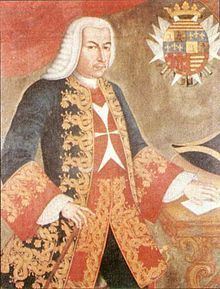Died 1783, Madrid, Spain | ||
 | ||
Pedro Messía Corea de la Cerda, 2nd Marquis of Vega de Armijo (February 16, 1700 in Córdoba, Spain – 1783 in Madrid) was a Spanish naval officer and colonial official. From 1761 to 1773 he was viceroy of New Granada (present-day Colombia, Venezuela, Panama and Ecuador).
Contents
Background and early career
Pedro Messía Corea de la Cerda was a knight of the Gran Cruz de Justicia of the Order of San Juan, gentleman of the king's bedchamber, and knight commander of the Golden Key. He entered the navy, participating in the conquest of Sardinia and the reconquest of Sicily. In 1719 he took part in various battles with the English.
He made his first voyage to the Americas in 1720, and in 1721 he was involved in the suppression of smuggling in Cartagena and Portobelo. In 1726 he was promoted to lieutenant of a frigate, and in 1745 he was made captain.
In 1747 de la Cerda was Captain of the ship of the line Glorioso, during this time occurred the famous Voyage of the Glorioso or the battles of the Glorioso, this were four naval engagements fought during the War of the Austrian Succession between the Spanish 70-gun ship of the line Glorioso and several British squadrons of ships of the line and frigates which tried to capture it. The Glorioso, carrying four million silver dollars from the Americas, was able to repel two British attacks off the Azores and Cape Finisterre, successfully landing her cargo at the port of Corcubión, Spain.
Several days after unloading the cargo, while sailing to Cadiz for repairs, Glorioso was attacked successively near Cape St Vincent by four British privateer frigates and the ships of the line HMS Dartmouth and HMS Russell from Admiral John Byng's fleet. The Dartmouth blew up killing most of the crew, but the 92-gun Russell, finally forced the Glorioso to strike the colours. The British took her to Lisbon, where she had to be broken up because of the extensive damage suffered during the last battle. The commander of the ship, Pedro Messia de la Cerda, and his men, were taken to Great Britain as prisoners, but were considered heroes in Spain and gained the admiration of their enemies. Several British officers were court-martialed and expelled from the Navy for their poor performance against the enemy.
In 1753 when he was in Cartagena de Indias in charge of a military force for the suppression of privateers and smugglers, he received and entertained the new viceroy, José Solís Folch de Cardona upon his arrival there. In 1755 he became lieutenant general of the navy, and two years later was named a member of the Supreme Council of War.
As viceroy of New Granada
In March 1760 Messía was named viceroy of New Granada. He arrived at Cartagena in October to take up his office. Arriving with him was the physician and botanist José Celestino Mutis, later head of the royal botanical expedition that investigated the flora and fauna of the colony. Messía traveled to Bogotá at the end of February 1761, where he was received with due ceremony. He returned to Cartagena in September 1762, upon receiving news of the British blockade of Havana. Then he returned to the capital in 1763.
On instructions from the Crown, he imposed a tax on tobacco. He also took steps to stimulate the mineral production in the colony. During his administration a gunpowder factory was established in the capital, and a saltpeter factory in Tunja. He reorganized the treasury, reinforced the fortifications of Cartagena, and promoted public works, such as the road from Bogotá to Caracas. He promoted higher education and established a postal monopoly. He also increased the tax on aguardiente. In May 1765 this led to a revolt in Quito.
He aided the governor of Darién in fighting back the invasions of the Cuna Indians. He also carried out campaigns against the Chimila and Guajiro (Wayuu) Indians, who had not yet been subjected by the Spanish. These campaigns were not very successful. He also faced an Indian attack on the town of Coyaima, where the rebels killed some people, burned some buildings and forced the corregidor to flee. He restored order in Neiva in 1767 after another rebellion.
Messía promoted the missions, also without major results. He began the construction of the cathedral of Santa Marta. The first stone was laid on December 8, 1766.es:Catedral Basílica de Santa Marta
He carried out the order of King Charles III to expel the Jesuits from New Granada (and all the other Spanish dominions), and he established a mechanism to administer the property confiscated from the Order. Messía de la Cerda was a friend of the Jesuits, and tried to mitigate the harshness of the expulsion order. Nevertheless, it was enforced on July 31, 1767. At the time there were 114 Jesuit priests, 57 students and 56 brothers in the colony. Many of the individuals expelled took up residence in Urbino, Italy, where a number of them, through their writings, supplied European scholars with more information about the Americas.
Return to Spain
In 1771 the king approved his request to return to Spain, pending the arrival of his successor, Manuel de Guirior. On September 14, 1772 he left for Cartagena, and the following month turned over the office of viceroy to Guirior.
He lived ten years in Spain, dying there in 1783.
